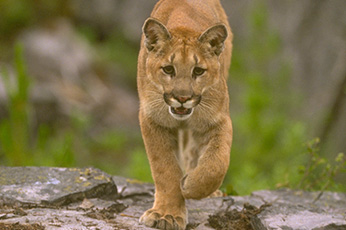South San Francisco, CA June 1, 2021 by SMC Alert
On 05/31/2021, at approximately 7:00PM, a resident believed they saw a mountain lion on the 600 blk of Sequoia Ave, Millbrae. There was no photographic evidence and no additional sightings have been reported. Sheriff’s deputies searched the neighborhood without seeing a lion. Coyotes are endemic to the entire Peninsula and have been seen all over Millbrae. Lion sightings should be called in to 9-1-1. For more information about mountain lions, visit the California Department of Fish and Wildlife website for further. Sgt. Heffelfinger, San Mateo County Sheriff’s Office, Millbrae Patrol Bureau.
Keep Me Wild: Mountain Lion
California Mountain Lions
More than half of California is mountain lion habitat. Mountain lions generally exist wherever deer are found. They are solitary and elusive, and their nature is to avoid humans.
Mountain lions primarily eat deer, but, if allowed, they will prey on vulnerable pets and livestock. In extremely rare cases, even people have fallen prey to mountain lions.
In recent years, there have been ever-increasing interactions between people and mountain lions. As a result, CDFW has developed strategies to address the risk of mountain lions on the landscape, and highly trained scientific and law enforcement staff address all cases of human conflicts with mountain lions. Importantly, cases where mountain lions threaten people are immediately addressed. In cases when livestock or pets are killed by mountain lions, the CDFW has established decision-making processes in issuing permits for mountain lion depredation, which are rooted in the depredation provisions of Proposition 117 (Fish and Game Code sections 4800-4810). Since 2017, CDFW’s approach has been deliberative, starting with a three-step policy being implemented in the Santa Monica Mountains and Santa Ana Mountains. In February 2020, the policy was expanded to the larger proposed evolutionarily significant unit (ESU) contained in the petition to the Fish and Game Commission (more below) to list mountain lions under the California Endangered Species Act (CESA). The proposed ESU encompasses an area stretching from San Francisco in the north to the Mexico border the south and from I-5/I-15 in the east to the coast. A primary focus of the three-step deliberation is to prioritize and pursue approaches and actions that are non-lethal in accordance with Fish and Game Code section 4801.5, which provides that non-lethal measures shall be used when issuing depredation permits unless otherwise stated in Chapter 10 of Division 4 of the Fish and Game Code.
In July 2019, the Center for Biological Diversity petitioned the Commission to list mountain lions as threatened under CESA within a proposed ESU located in Southern California and along the central coast of California. In April 2020, the Commission found that listing of this ESU may be warranted and designated mountain lion within the ESU as a candidate species under CESA. As a result, CDFW is now completing a 12-month status review of mountain lions within the proposed ESU. At the end of the review, CDFW will make its recommendation on listing to the Commission. Under CESA, species classified as a candidate species are afforded the same protection as listed species. As a result, mountain lions in this proposed ESU are CESA-protected during the review period.
Help prevent unwanted conflicts with these beautiful wild animals. Do your part, keep them wild.
Living in Mountain Lion Country
- Acknowledge that you live in mountain lion country and make a commitment to educate yourself. Talk to your neighbors and work together.
- Never feed deer or other wildlife; it is illegal to feed deer and other big game in California and it will attract mountain lions.
- Deer-proof your landscaping by avoiding plants that deer like to eat. For tips, request A Gardener’s Guide to Preventing Deer Damage from CDFW offices.
- Trim brush to reduce hiding places for mountain lions.
- Don’t leave small children or pets outside unattended.
- Install motion-sensitive lighting around the house.
- Provide sturdy, covered shelters for sheep, goats, and other vulnerable animals.
- Don’t allow pets outside when mountain lions are most active—dawn, dusk, and at night.
- Bring pet food inside to avoid attracting raccoons, opossums and other potential mountain lion prey.
What to do if you Encounter a Mountain Lion
Mountain lions are quiet, solitary and elusive, and typically avoid people by nature. However, as human population expands into mountain lion habitat, more frequent sightings may occur and human/mountain lion encounters may increase.
Mountain lion attacks on humans are extremely rare. However, attacks have occurred in California. Understanding mountain lion behavior and how to act responsibly in mountain lion country may greatly reduce potential conflict with these majestic animals.
The following safety information is a compilation taken from wildlife managers, wildlife officers and scientists that study mountain lion behavior. Although no strategy in the event of an encounter is guaranteed to be successful in every situation, these tips will help keep you safe in lion country.
- Do not hike, bike, or jog alone. Stay alert on trails.
- Avoid hiking or jogging when mountain lions are most active – dawn, dusk, and at night.
- Keep a close watch on small children.
- Off leash dogs on trails are at increased risk of becoming prey for a mountain lion.
- Never approach a mountain lion. Give them an escape route.
- DO NOT RUN. Stay calm. Running may trigger chase, catch and kill response. Do not turn your back. Face the animal, make noise and try to look bigger by waving your arms, or opening your jacket if wearing one; throw rocks or other objects. Pick up small children.
- Do not crouch down or bend over. Squatting puts you in a vulnerable position of appearing much like a 4-legged prey animal.
- Be vocal; however, speak calmly and do not use high pitched tones or high pitch screams.
- Teach others how to behave during an encounter. Anyone who runs may initiate an attack.
- If a lion attacks, fight back. Research on mountain lion attacks suggests that many potential victims have fought back successfully with rocks, sticks, garden tools, even an ink pen or bare hands. Try to stay on your feet. If knocked down, try to protect head and neck.
- If a mountain lion attacks a person, immediately call 911.
- Report unusual mountain lion behavior to your local CDFW regional office.

the major cause in increasing sightings is the refusal of the state to control the
mountain lion population, under the idiotic edict issued by the state (specifically wish & wild life) these killers are allowed to breed unchecked,
consequently these killers are running
out of living space, and prey to feed upon, the killing animal lovers in
sacramento, would rather human beings become “happy meals”for these predators, rather than culling the population, so who is more important,
idiotic animal lovers or human beings,
think about it, especially if you become
a “happy meal”